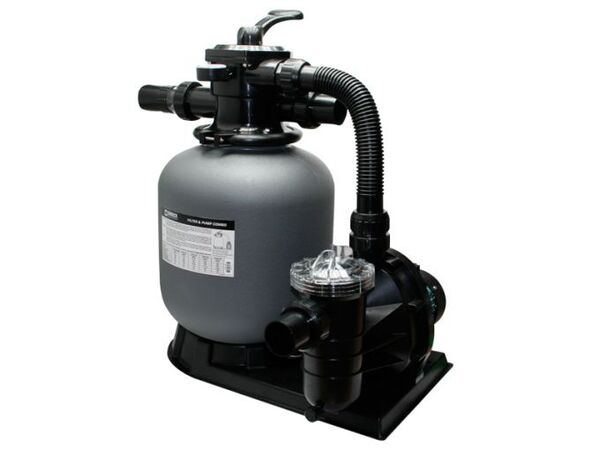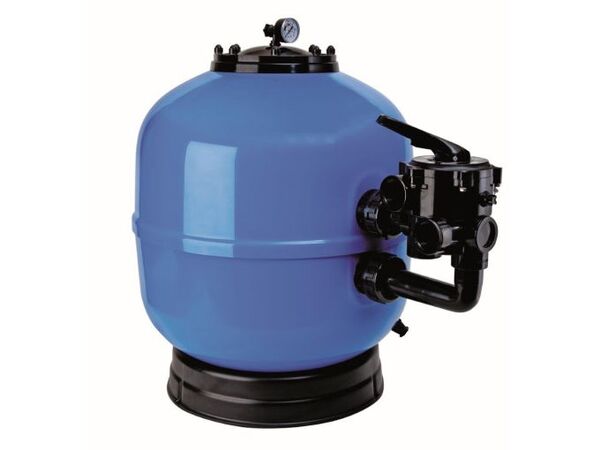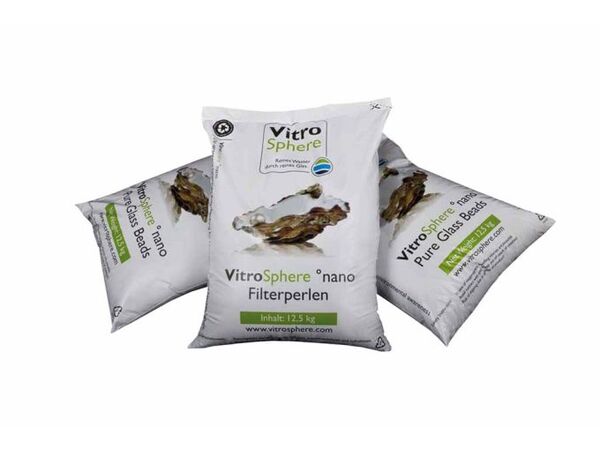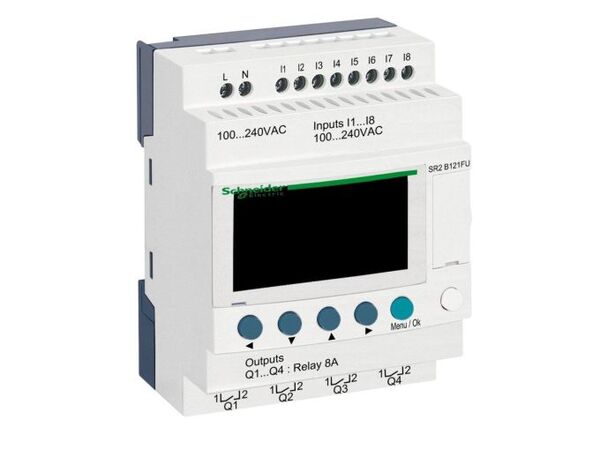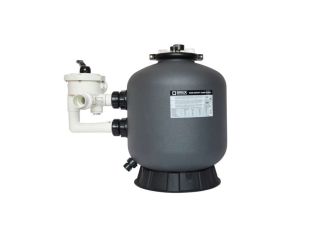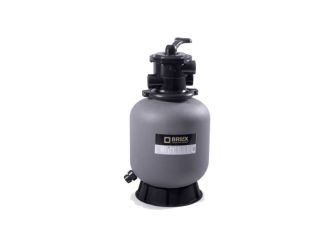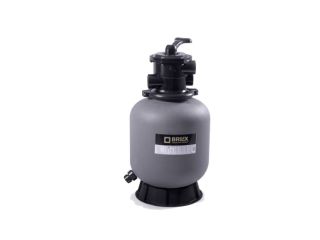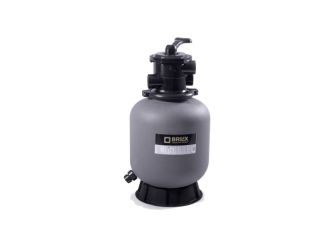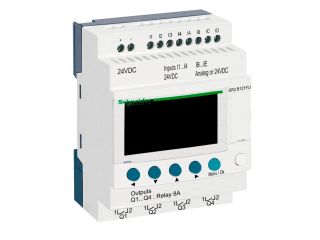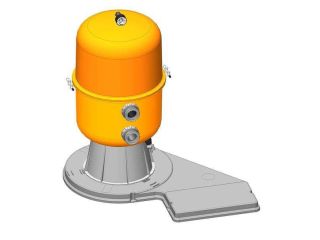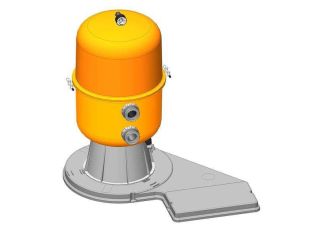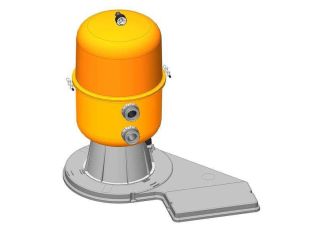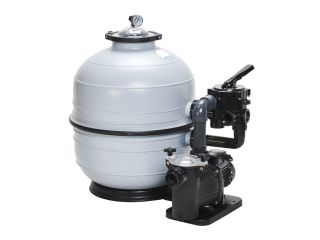Filters and Filtration Equipment
The sand filter container is part of the filter circuit that ensures the pool water is cleaned. Impurities are caught and only clean water is returned to circulation using sand filtration.
Sand Filtrations
Sand filtration is used to catch impurities contained in pool water using natural principles. Its essence is water flow through the filter cartridge, where mechanical impurities are caught, and clean water is returned to the pool.
The filter filling consists of layers of silica sand of different grain sizes (possibility of an additional layer of material with special properties). The smaller the number of layers the filter has, the higher the requirements for chemical water treatment. If the gaps between the grains of sand are too large, it's necessary to reduce them by using coagulant (a substance that captures even very small particles on its surface and is washed into the sewer along with dirt when the filter is washed). The maintenance requirements of sand filtration are minimal: the sand filling is washed as standard once a week (depending on the pool's load), replacing the sand is necessary once every 2 to 3 years.
Pool filtration connection:
- Ensure that there's a sufficient amount of filter sand in the filter container and that all necessary connections are made and secured.
- Press the control valve lever and direct it to the BACKWASH position. (To avoid damaging the valve scale, press the lever each time before turning).
- Prime the pool pump sufficiently, this means that the filter container will be filled with water. Then plug it in accordance with the instructions (make sure all suction and return lines are open), Once the water is coming out of the drain hose, let the pump run for at least one minute. The initial rinsing of the sand is recommended to remove dirt and fine particles that could enter the pool.
- Turn off the pool pump and adjust the valve to the RINSE position. Turn on the pump and let it run for about half a minute to a minute until the water in the sight glass is completely clear. Then, turn the pump off again, set the valve back to the FILTER position, and plug the pump back in. The filtration now runs in normal filtration mode and filters all impurities from the pool water.
- You need to adjust the suction and return valves, in order to achieve the given flow-rate. Check that there are no water leaks from the system and the filter, and if necessary, tighten the connections, bolts or nuts.
- When starting the filtration cycle, remember to record the pressure as long as the filtration is clean. (This value differs from pool to pool depending on the pump used and the pipe's length and shape). After some time, due to impurities accumulating in the filtration, the pressure increases and the water flow also decreases. As soon as the manometer shows 125 kPa, which is more than the initial pressure with a "clean" filter, it's high time to flush the filtration (see below in the chapter "Positions of the multi-way valve - Flushing").
When cleaning new pool water for the first time, it may be necessary to rinse the filter sand more often, as this water contains more impurities.
Meaning of multi-way valve positions:
FILTRATION
This is the basic position used to filter the pool water. Activate this function according to the following instructions:
Turn off the pool pump and set the multi-way valve lever to the "Filtration" position. Now, you turn the pump back on. During operation, occasionally check the pressure shown by the manometer in order to have an overview of the filter condition (it's clogged with dirt). The normal pressure in the filter vessel should be around 0.8 Kp/cm2. However, as soon as the pressure starts to reach a value of around 125 kPa, you should perform a so-called flushing. (The given values are only indicative and may differ from pool to pool depending on the pump used and the pipe's length and shape).
FLUSH
This is a reverse flow filter cleaning function. It's intended for washing sand and removing impurities from the filter. In every sand filling during filtering, innumerable passageways are created, which then retain the impurities contained in the pool. As soon as these impurities are stuck into the filtration, the number of passageways decrease and the pressure in the filter increases. Once a pressure of around 125 kPa is reached, the filter sand can no longer hold more dirt and it's therefore necessary to carry out a backwash.
Turn the pool pump off. Preset the control valve to the "Flush" position.
With the suction and discharge valves fully open, plug the pump in and let it run for around 2 minutes. The dirty water is directed into the waste, and the pool level subsequently drops. After the program ends, the filter is clean again and therefore ready for further filtering.
FILTERING
This function is always used after flushing and is intended to flush dirt from the filtration. This is the so-called finishing position during flushing. If you were to flush the filter and start filtering immediately afterwards, you would have cloudy water flowing into the pool in the first few seconds. This water carries with it small impurities that were not enough to float away during the flushing function. In order to avoid this phenomenon, this "Filtering" position is here.
- Immediately after flushing, set the control valve to the filter position.
- Leave the pool pump on for 1 minute.
- Turn the pool pump off. Set the control valve to the filtering position.
- When the filter control valve is in the position, the water doesn't return to the pool, but is directed to the drain, which is why the pool water level drops.
WASTE
The filter outlet is intended for vacuuming water into the waste. This function can also be used to lower the pool water level.
RECIRCULATION
This is also a filter bypass, but with the possibility of pumping water into the pool without filtering.
CLOSED
This function is used to close the flow to the filter or to the pool. Use this position when you need to clean the dirt basket of the pool pump, or during its repair, maintenance, etc. If you have this function set on the multi-way valve, never turn the pump on!
A few final recommendations:
- You must switch off the pool pump before operating the six-way valve.
- Never turn the device on without water.
- Never connect the filter directly to the water source from the water supply system. The water pressure from the water supply system could be much higher than the maximum pressure of the filter.
- Never start the pool pump if the position on the six-way valve is in the closed position or if the pipes in the circulation system are blocked. This could cause a higher pressure than the normal working pressure and subsequently damage, crack or tear the six-way valve cover, which could cause injury or property damage.
- It is not allowed to sit down or put any weight on the device.
- Never use solvents to clean the filter lid and the filter container itself, as this could damage its surface (loss of gloss, transparency, etc.).
- Regular cleaning of the pool pump’s hair filter and skimmer basket is recommended for proper operation. This prevents possible pump damage and simultaneously ensures the system's proper and reliable functioning.
- If the pump is switched on, don't unscrew the flange couplings.
- Don't forget that all joints have gaskets. For this reason, over tightening the nuts are unnecessary. Dragging could damage the plastic parts.


